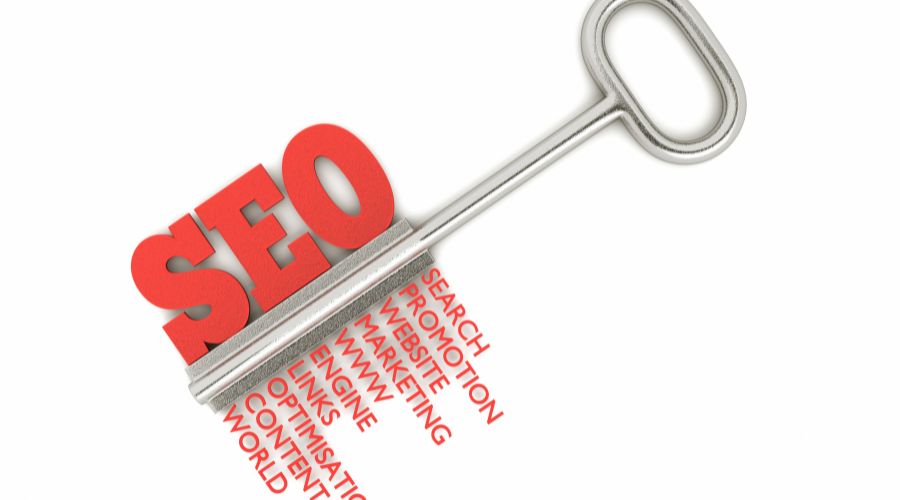Understanding Search Engine Optimization (SEO) is crucial for anyone aiming to enhance their website’s visibility and attract more visitors. SEO is a set of strategies and techniques dedicated to improving a website’s position on search engine results pages (SERPs). This not only drives organic traffic but also ensures that your content reaches the right audience.
This article serves as a comprehensive beginner’s guide to SEO. It aims to demystify the concept, breaking down its key components and offering practical strategies tailored for small businesses. Many small enterprises face challenges such as budget constraints and limited digital marketing expertise. By addressing these hurdles, this guide will equip you with the foundational knowledge needed to navigate the world of SEO effectively.
1. What is SEO?
Search Engine Optimisation (SEO) is a digital marketing strategy focused on enhancing the visibility of a website in search engine results pages (SERPs). This process involves various techniques that help search engines like Google understand and rank your website more favourably, increasing the likelihood of attracting organic traffic.
At its core, SEO works by optimising different elements of a website to align with search engine algorithms. These algorithms assess numerous factors, such as keyword relevance, site structure, content quality, and user engagement metrics. By aligning your site’s components with these factors, you improve your chances of appearing higher in SERPs when users search for terms related to your business.
The role of SEO in boosting website visibility cannot be overstated. An effective SEO strategy enhances your site’s ranking on SERPs, which is crucial because:
- Higher rankings lead to increased visibility: Users are more likely to click on websites that appear on the first page of search results.
- Increased visibility drives organic traffic: Unlike paid ads, organic traffic is cost-effective and sustainable over time.
- Organic traffic often yields higher engagement: Users who find your site through organic search are typically more interested and engaged.
Investing time in understanding the basics of SEO can significantly impact the success of your digital presence. This guide aims to demystify SEO fundamentals for beginners, equipping you with the knowledge to improve your website’s performance and leverage SEO as a powerful tool for growth.

2. Key Components of SEO
Keyword Research
Conducting thorough keyword research is a cornerstone of an effective SEO strategy. Understanding the keywords your target audience uses enables you to tailor your content to align with their search intent. This alignment ensures that your website attracts relevant traffic, enhancing its visibility on search engine results pages (SERPs).
Significance of Keyword Research
Keywords are the bridge between what people are searching for and the content you provide to fulfill needs. Identifying the right keywords involves understanding user intent—what users hope to achieve with their search. Whether they’re looking for information, making a purchase, or seeking a service, aligning your content with these intents increases the likelihood of attracting visitors who find your content valuable.
Keyword Research Tools
Several tools can simplify this process, providing insights into search volume, keyword difficulty, and related terms. Google Keyword Planner is a free tool that offers valuable data on keyword trends and forecasts. It allows you to discover new keywords related to your business and gain insight into how often certain words are searched and how their popularity changes over time.
Another powerful tool is SEMrush, which offers comprehensive analytics for SEO and online visibility across various channels. SEMrush provides features like keyword suggestions, competition analysis, and trend data—all essential for developing an effective keyword strategy. This tool helps you understand competitors’ strategies by providing insights into their top-performing keywords.
On-Page SEO
On-page SEO involves optimising individual pages on your website to improve rankings and earn more relevant traffic. Key elements include:
- Title Tags & Meta Descriptions: Crafting compelling title tags and meta descriptions helps search engines understand the content of your web page while enticing users to click through from SERPs.
- URL Structure & Header Tags: A clear URL structure aids both search engines and users in navigating through your site seamlessly. Similarly, using header tags properly organises your content, making it more readable.
- Crafting Content with Keywords: While incorporating target keywords is crucial,theyy must appear naturally within engaging content. This approach not only improves readability but also aligns with search engines’ emphasis on user experience.
Technical SEO Techniques for Small Businesses
Technical SEO ensures that search engines can effectively crawl and index your website. For small businesses, addressing technical issues like site speed or mobile-friendly design is vital:
- Site Speed: A fast-loading site enhances user experience and reduces bounce rates—a critical factor in ranking algorithms.
- Mobile-Friendly Design: With an increasing number of searches conducted on mobile devices, ensuring a mobile-friendly design is non-negotiable.
Understanding these components provides a solid foundation for any small business aiming to improve its online presence through SEO practices. Engaging with tools like Google Keyword Planner and SEMrush will deepen your insights into keyword relevance aligned with user intent, setting the stage for successful on-page optimisation efforts.
On-Page Optimisation
On-page SEO is a crucial aspect of improving your website’s visibility and attracting relevant traffic. This involves refining various elements on your web pages to align with search engine algorithms and user intent.
Title Tags
Title tags are one of the most significant components, acting as the first impression in search results. Crafting concise and descriptive titles that include primary keywords can enhance click-through rates.
Meta Descriptions
Meta descriptions play a similar role, providing a summary of your page’s content underneath the title tag in SERPs. While meta descriptions don’t directly impact rankings, they influence user behaviour by enticing clicks, thereby indirectly affecting SEO.
URL Structure
The URL structure is another pivotal element, as a clean and descriptive URL can improve both user experience and search rankings. Incorporating target keywords into URLs helps search engines understand the page’s context while offering users a clearer navigation path.
Header Tags
Header tags, ranging from H1 to H6, help organise content and signal its hierarchy to both users and search engines. The H1 tag should contain your main keyword and act as the primary headline for the page, while subsequent tags break down sections logically.
Compelling Content
Crafting compelling content is at the heart of on-page optimisation. By naturally incorporating target keywords identified through keyword research tools like Google Keyword Planner or SEMrush, you ensure that your content aligns with what users are searching for. This not only improves relevance but also enhances engagement.
By paying attention to these on-page SEO best practices, you can create a more user-friendly experience that meets both search engine guidelines and visitor expectations.
Technical SEO Techniques for Small Businesses
Technical SEO plays a crucial role in ensuring that search engines can effectively crawl and index your website. It forms the foundation of your SEO strategy and is essential for improving your site’s visibility. There are several important elements to consider when optimising a website for search engines, including site speed and mobile-friendly design.
Common Technical Issues Small Businesses Face
- Slow Site Speed: This can deter users and negatively impact your rankings.
- Non-Mobile-Friendly Design: With an increasing number of users accessing websites via mobile devices, having a responsive design is crucial.
Solutions to Improve Site Speed
To tackle slow site speed, consider implementing the following techniques:
- Compress images to reduce their file size without sacrificing quality.
- Use browser caching to store certain elements of your website in users’ browsers, reducing load times on subsequent visits.
- Reduce server response time by optimising your hosting environment or switching to a faster hosting provider.
Tools like Google PageSpeed Insights can help identify areas for improvement in your site’s performance.
Ensuring Mobile-Friendliness
Make sure your website is responsive, with a design that adjusts seamlessly to different screen sizes. Test your site using Google’s Mobile-Friendly Test tool to ensure it meets mobile usability standards.
Other Technical SEO Best Practices
Beyond site speed and mobile-friendliness, here are some additional technical aspects you should focus on:
- Structured Data: Implement schema markup to help search engines understand your content better.
- XML Sitemaps: Submit a sitemap to Google Search Console to aid in crawling.
- HTTPS Security: Secure your site with HTTPS to protect user data and boost trustworthiness.
By addressing these technical issues and aligning with best practices, you create a strong foundation for other SEO efforts such as keyword research, on-page optimisation, and building relevant traffic through high-quality content. For small businesses looking to make an impact online, focusing on technical SEO is a vital step toward achieving better search engine rankings.
Creating High-Quality Content That Ranks Well on Google
Producing unique and valuable content is essential in meeting user needs and encouraging engagement. High-quality content not only attracts relevant traffic but also plays a significant role in on-page SEO. It involves understanding user intent and aligning your content to provide answers or solutions that users are actively searching for.
Structuring Content for Readability
Structuring content for readability is crucial. Effective strategies include:
- Headings: Use clear and descriptive headings to break up text and improve navigation.
- Bullet Points and Lists: Simplify complex information with bullet points or lists, making it easier for readers to digest.
- Visuals: Incorporate images, infographics, or videos to enhance understanding and engagement.
Optimising Technical SEO Elements
Optimising elements such as title tags and meta descriptions can improve click-through rates by providing succinct summaries of what users can expect from your content. These components are integral to technical SEO, ensuring that your website remains accessible and appealing to both users and search engines.
Considering User Experience Factors
High-quality content must also consider factors like site speed and mobile-friendly design. Ensuring that your website loads quickly on all devices enhances user experience, which is a critical ranking factor for search engines.
Conducting Keyword Research
Utilising keyword research tools like Google Keyword Planner or SEMrush helps identify terms that align with user intent, enabling you to create content that fulfills these queries effectively. Understanding “What is SEO” goes beyond technical aspects; it encompasses creating engaging content that naturally incorporates keywords while maintaining readability and value for the audience.
This approach ensures your content not only ranks well but also resonates with users, driving organic traffic to your site.
Building Backlinks to Boost Your Website’s Authority
Backlinks are like votes of confidence from one website to another. They tell search engines, such as Google, that your content is trustworthy and valuable. When respected sources link back to your site, it improves your website’s authority, which is crucial for getting higher rankings on search engine results pages (SERPs). Backlinks are an important aspect of SEO because they help attract relevant traffic by increasing your visibility.
Strategies for Small Businesses to Build Backlinks
Here are some effective strategies that small businesses can use to build backlinks:
- Guest Blogging: Write articles for other blogs in your industry. This not only establishes you as an expert but also allows you to include links back to your website.
- Influencer Outreach: Reach out to industry influencers and ask them to mention or link back to your site. Their established audiences will trust their recommendations, boosting your website’s credibility.
- Content Collaboration: Partner with other businesses or experts to create joint content pieces. This can lead to natural backlink opportunities and expand your reach.
- Directories and Listings: Submit your business information to online directories and industry-specific listings. Make sure these platforms are reputable to maintain a positive impact on your site’s authority.
Quality Over Quantity
When building backlinks, it’s important to remember that quality is more important than quantity. Links from reputable sources carry much more weight than many links from low-quality sites.
Integrating Link Building with Other SEO Efforts
Incorporating effective link building techniques into your SEO strategy works hand in hand with other elements like keyword research, on-page SEO, and technical SEO aspects such as title tags and meta descriptions. This holistic approach leads to better search engine optimisation results.
Enhancing User Experience (UX) Through Effective Site Design
The relationship between user experience (UX) and SEO performance is crucial in achieving a successful online presence. A well-designed website not only attracts relevant traffic but also retains visitors by ensuring they have a seamless browsing experience. Key factors such as site navigation and loading speed significantly influence both UX and search engine rankings.
Site Navigation
- Streamline your website’s structure to make it intuitive and easy to navigate.
- Use clear and descriptive labels for menu items, enhancing the accessibility of your content.
Loading Speed
- Optimise images and implement browser caching to improve site speed, a critical component of technical SEO.
- Tools like Google PageSpeed Insights can offer insights into your current site performance.
Mobile-Friendly Design
- Ensure your site is responsive, adapting to various screen sizes without sacrificing usability.
- Test your website across multiple devices to guarantee a consistent user experience.
On-Page SEO Elements
- Incorporate title tags and meta descriptions that are concise yet informative, aligning with user intent identified during keyword research.
- Maintain consistency in your content by naturally integrating target keywords, thus satisfying both search engines and users.
Adhering to these user experience best practices not only enhances engagement but also supports other SEO efforts such as on-page optimisation. Quality UX encourages longer visits, reducing bounce rates and signaling to search engines that your site offers valuable content. As you continue to refine your website’s design, remember that practical enhancements contribute significantly towards a more effective SEO strategy.

Monitoring Your Website’s SEO Performance with Analytics Tools
Understanding how your SEO efforts translate into actual performance is essential for maintaining and improving your website’s visibility. Two indispensable tools for tracking and analysing SEO performance are Google Search Console and Google Analytics.
1. Google Search Console: Insights from the Source
Google Search Console provides a direct insight into how Google perceives your website. It offers valuable metrics like search queries that drive traffic, indexing status, and potential errors affecting site visibility. With this tool, you can monitor the effectiveness of your keyword research by seeing which terms lead users to your site. It’s also instrumental in refining on-page SEO elements such as title tags and meta descriptions. Fixing technical issues like slow site speed or ensuring a mobile-friendly design becomes more manageable when you have direct feedback from Google itself.
2. Google Analytics: Understanding User Behaviour
On the other hand, Google Analytics helps you dive deeper into user behaviour on your website. This tool tracks visitor interactions, providing insights into page views, bounce rates, and session durations. By analysing these metrics, you can gauge whether your content aligns with user intent and attracts relevant traffic. It also highlights how well-structured your internal linking is and if your technical SEO efforts are fruitful.
3. Combining Forces for Small Business Success
For small businesses aiming to enhance their digital presence, combining these tools offers a comprehensive view of SEO performance. By regularly reviewing these analytics, you can make informed decisions to adjust strategies, ensuring continuous improvement in search engine rankings.
Local SEO Strategies for Small Businesses Targeting Specific Geographic Areas
Local SEO is a crucial factor for small businesses aiming to attract customers within specific geographic areas. By optimising your website and online presence for local search, you can drive relevant traffic and improve visibility among potential clients in your vicinity.
Significance of Local Optimisation
For businesses with a physical location or those serving a particular region, local optimisation ensures that you appear in search results when users are looking for products or services nearby. This involves tailoring your on-page SEO elements, such as title tags and meta descriptions, to reflect local keywords. Additionally, technical SEO aspects like site speed and mobile-friendly design play a role in how search engines rank your site locally.
Actionable Tips for Managing Online Listings
- Claim Your Google My Business (GMB) Listing: A verified GMB profile enhances your visibility on Google Maps and local search results. Make sure all information is accurate and up-to-date.
- Encourage Positive Customer Reviews: Reviews influence potential customers and impact your ranking in local searches. Encourage satisfied clients to leave positive feedback on platforms like Google and Yelp.
- Consistent NAP Information: Ensure that your business Name, Address, and Phone number (NAP) are consistent across all online directories and listings to enhance credibility.
- Utilise Local Keywords: Incorporate location-specific keywords naturally into your content, such as blog posts and service pages, to align with user intent seeking nearby solutions.
- Engage with the Community: Participate in local events or sponsor community activities to build rapport and generate backlinks from reputable local sources.
These strategies enable small businesses to maximise their reach within targeted geographic areas, ensuring they capture the attention of potential customers effectively. Implementing these techniques not only improves local search performance but also strengthens overall brand presence within the community.
Challenges in Implementing Effective SEO Strategies as a Small Business Owner
Small business owners often encounter significant hurdles when attempting to implement effective SEO strategies.
1. Budget Constraints
Budget constraints are a primary concern, as small businesses typically operate with limited financial resources, making it difficult to invest in comprehensive SEO campaigns or hire specialised digital marketing experts.
2. Lack of Digital Marketing Expertise
A lack of digital marketing expertise is another common challenge. Many small business owners may not possess the necessary knowledge or skills to navigate the complex world of SEO. This gap can lead to ineffective strategies that fail to improve search visibility or drive organic traffic.
3. Limited Resources
Small businesses often struggle with allocating time and personnel to focus on SEO efforts alongside their core business operations.
4. Technological Barriers
Keeping up with the latest SEO tools and technologies can be daunting without dedicated technical support.
Addressing these challenges requires strategic planning and leveraging available resources wisely, ensuring that even with constraints, effective SEO tactics can be pursued.
Conclusion: Embracing Ongoing Learning in Your Journey Towards Successful Search Engine Optimisation
Understanding what SEO is marks the beginning of a continuous journey that demands dedication and adaptability. SEO is not a one-time task but an ongoing process that evolves with changing algorithms, user behaviour, and technological advances. This dynamic landscape requires you to remain informed and agile.
- Stay Informed: Regularly update your knowledge with the latest trends and algorithm changes.
- Adapt Strategies: Modify your approaches based on performance metrics and market shifts.
- Engage with Community: Participate in forums, webinars, and workshops to exchange ideas and learn from others.
Adopting this mindset will enable you to maintain a competitive edge. As you navigate through this evolving field, remember that each new insight or adjustment brings you closer to achieving sustainable online success. Keeping pace with developments helps transform challenges into opportunities for growth.
Call to Action: Take the First Step Towards Improving Your Online Presence with Our Free Website Health Check Tool!
Understanding what is SEO is just the beginning of your journey towards enhanced online visibility. Small Biz Optimize offers a Free Website Health Check Tool—a valuable resource designed to help you kickstart your quest for better search engine rankings. This complimentary service, valued at $375, provides insights into:
- SEO Performance: Identify areas where your website can improve.
- Technical Issues: Detect problems that may be hindering your site’s visibility.
- Content Quality: Assess how well your content aligns with SEO best practices.
By leveraging this tool, you gain a clearer understanding of your website’s current standing and actionable steps to optimise it. Don’t wait—embrace this opportunity to enhance your digital presence and outshine competitors. Visit Small Biz Optimize today to access your free report and take a decisive step towards achieving your business goals.
What is SEO and why is it important for websites?
SEO, or Search Engine Optimization, is the process of improving a website’s visibility on search engine results pages (SERPs) to drive organic traffic. It is crucial for websites as it helps increase their reach and attracts potential customers, ultimately contributing to business growth.
What are the key components of SEO?
The key components of SEO include keyword research, on-page optimization, technical SEO, high-quality content creation, link building, and enhancing user experience. Each component plays a vital role in ensuring that a website ranks well in search engines and provides relevant content to users.
How does keyword research impact my SEO strategy?
Keyword research is essential as it helps identify relevant search terms that align with user intent. By understanding what users are searching for, businesses can create content that meets those needs and optimize their websites accordingly. Popular tools for keyword research include Google Keyword Planner and SEMrush.
What are some best practices for on-page optimization?
On-page optimization best practices include using relevant title tags, meta descriptions, structured URLs, and header tags. It is also important to craft compelling content that naturally incorporates target keywords while ensuring readability through headings, bullet points, and visuals.
Why is local SEO important for small businesses?
Local SEO is vital for small businesses targeting specific geographic areas as it helps them appear in local search results. Effective local SEO strategies include optimizing online listings, managing customer reviews, and ensuring consistent NAP (Name, Address, Phone Number) information across platforms.
How can I monitor my website’s SEO performance?
You can monitor your website’s SEO performance using tools like Google Search Console and Google Analytics. These tools provide valuable insights into metrics such as organic traffic, keyword rankings, and user behavior, enabling you to track progress and make data-driven adjustments to your SEO strategy.




